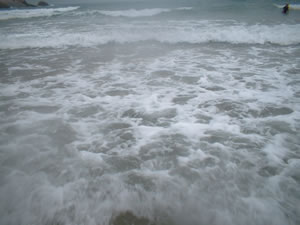Educational and Research Fields
[ Atmospheric and Marine Physics ]
1. What do you learn?You will learn the behavior of fluids covering Earth’s surface, such as the atmosphere and the ocean, and the roles they play in constituting Earth’s environment. Specifically, they are called Atmospheric Physics (Meteorology) and Marine Physics. Students will work on their fundamentals like basic mathematics, physics, and fluid mechanics, and for a graduation research project in the fourth year, work on a topic of your choice including those that relate to Okinawa’s subtropical and island environment. You will also learn how to write a good report and how to make a convincing presentation through the graduation research project.
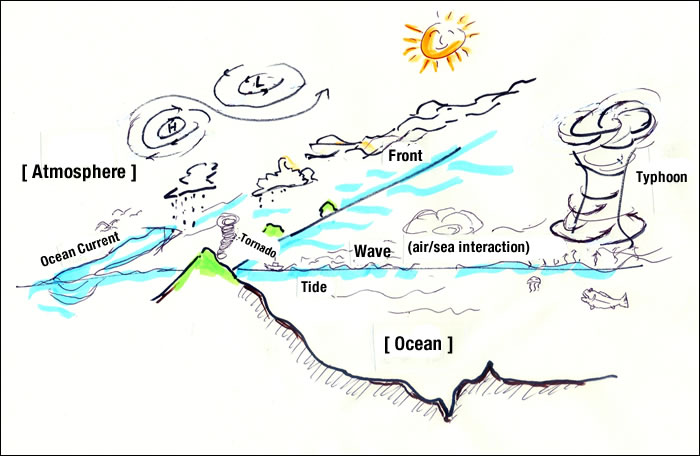
2. Main Subjects
Atmospheric and Marine Physics offers courses such as meteorology, typhoon physics, and merine physics. Undergraduate students are expected to build on their knowledge in disciplines like physics, physical mathematics, and fluid mechanics, and learn the characteristics of the atmosphere and the ocean in a broad and integrated way. For example, to provide a brief outline of Typhoon Physics, tropical cyclone energetics and the motion are explained according to the physical understanding. As for Marine Physics, you will learn the basics of large-scale ocean current circulation such as with the Kuroshio Current. Seeing the ocean current as a geostrophic wind will enable you to understand the distribution of water temperature and salt content of the ocean, the sea surface dynamic height (SSDH) level distribution, and how they are related to ocean current distribution.
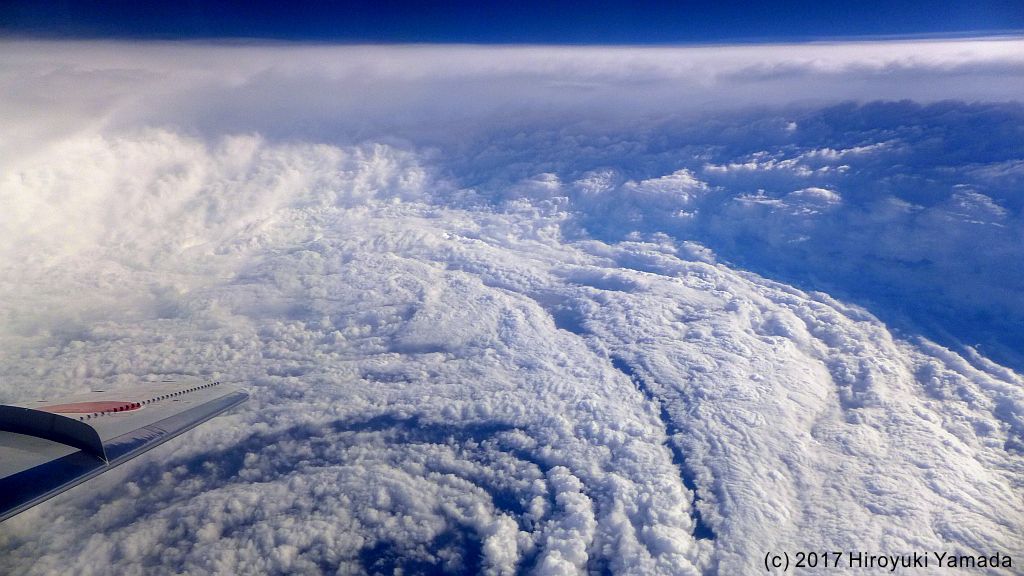
Figure: Inside of typhoon eye and eyewall (Photo taken by Hiroyuki Yamada from an aircraft, 21 October 2017).
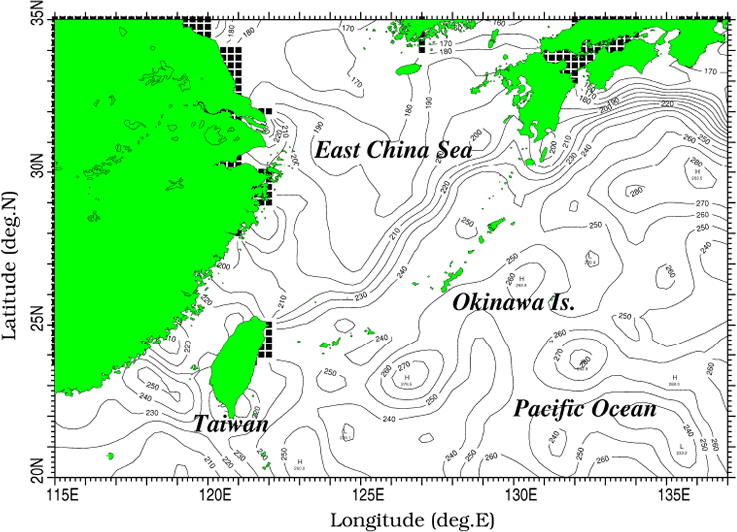
Figure: Contour map of SSDH (contour interval of 10cm, recorded late March, 2005) around Okinawa based on the satellite SSDH altimeter data (provided by AVISO). From the relational expression of the geostrophic wind, it is presumed that the series of contour lines in the area northwest of mainland Okinawa, extending toward Kyushu and Shikoku, represent the Kuroshio Current. The part of the Kuroshio Current along the east coast of Taiwan is not adequately exhibited since the satellite altimeter does not function well close to a continent or a large island. The vertical distribution on the south of mainland Okinawa is called oceanic mesoscale eddy (disturbance); it is not stable and steadily moves to west. Behaviors of large ocean currents and mesoscale eddies can be observed as changes occur.
3. What type of research is being conducted?
We conduct research projects that are suited to the characteristics of Okinawa’s atmosphere and seas. Some examples of atmosphere projects are: Research of rainfall characteristics in a subtropical oceanic climate, research on the course of typhoons, and rainfall prediction in areas affected by typhoons based on satellite observation data. In the ocean-related fields, some project examples include: Observation of changes in flow volume of the Kuroshio Current in the East China Sea (which is close to Okinawa), research of wave tendencies and oceanic currents, using an ocean radar, in Okinawa’s seas under the influence of the Kuroshio Current, and prediction of heat supply volume created by the atmosphere and the ocean in the East China Sea/Kuroshio Current area, based on satellite observation data. The figures below are rainfall predictions in areas affected by typhoons. The rainfall distribution image on the left was produced by integrating a number of satellite images of varying wavelengths, and therefore is much more detailed than the ground radar image (right).
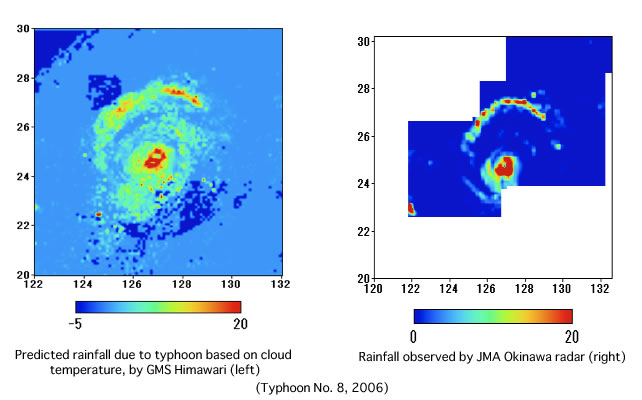
4. Recent Research Projects
We studied the flow of the ocean in the west coastal region of mainland Okinawa using an ocean radar. Ocean radar is a device that measures the speed and direction of the oceanic flow, as well as the height and direction of waves, by analyzing the electric wave reflections originally emitted from the device. The Kuroshio Current to the west of this area (west of Kume Island) flows in the northeastern direction, but we discovered that the flow was southward in this area. Also, this flow was enhanced depending on the wind.
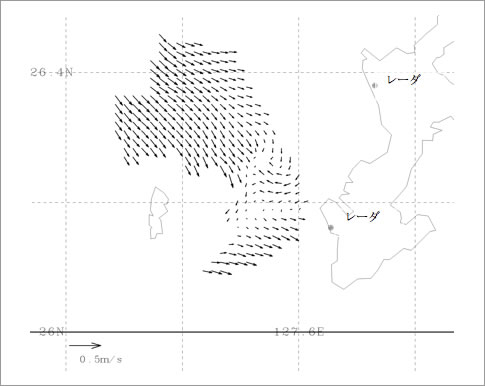
Examples of Graduation Thesis Topics
・Analysis of low pressure clouds with satellite imagery and adiabatic charts
・Prediction and verification of rainfall-affected zones due to typhoons using GMS Himawari imagery
・Analysis using an oceanic numerical model
・Seasonal and annual changes in the intertropical convergence zone and typhoon occurrence - course tendency
・Radial components of air currents inside the typhoon
・Spectral analysis of the sea-surface wind around the Ryukyu Archipelago
・Water temperatures and variations of sea-surface heat flux in the seas around mainland Okinawa
・Water temperature variations in the seas around Ishigaki Island
・Variations of wind direction and speed based on buoy data
Faculty
Associate Professor Hiroyuki YamadaResearch field: Meteorology and Atmospheric Physics
My field of interest is mainly in tropical meteorology, including the physical understanding of the organization and structure of convective cloud systems and tropical cyclones. Research is made using in-situ and remote-sensed observational data and cloud-resolving numerical models.
Laboratory webpage:https://metrq.skr.u-ryukyu.ac.jp/met_rq
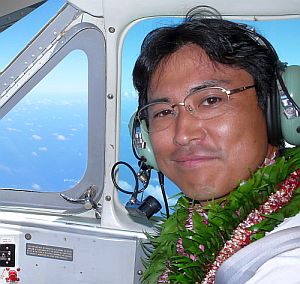
Associate Professor Kosuke Ito
Research field: Meteorology and Atmospheric Physics
Our group aims at improving the numerical weather prediction particularly associated with high-impact meteorological phenomena such as tropical cyclones and heavy rainfall events.
Laboratory webpage:https://www.itonwp.sci.u-ryukyu.ac.jp/index_e.html

Professor Yukiharu Hisaki
Research field: Physical Oceanography
Marine Physics is a discipline that seeks to discover the cause of various physical phenomenon related to the ocean, such as currents and waves. Our research unit uses remote sensing, which enables observation of the ocean either from land or by satellite using electromagnetic waves, to conduct research. We have a variety of research methods including observation, data analysis, theory, and numerical simulation. Recently we have been conducting research on air-sea interaction also, since physical phenomenon at sea are strongly related to the atmosphere. We invite students who are interested in various oceanic phenomenon to join our lab. See https://w3.u-ryukyu.ac.jp/yhisaki/ for more details.
Laboratory webpage:https://w3.u-ryukyu.ac.jp/yhisaki/
